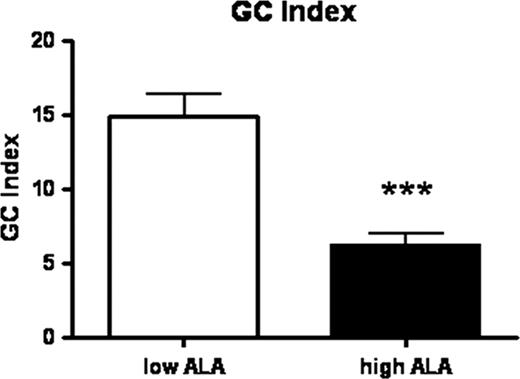Abstract
Abstract 2198
The plant-derived omega-3 fatty acid (FA) alpha-linolenic acid (ALA) may constitute an attractive cardioprotective alternative to fish-derived n-3 FA. Our recent studies have shown that ALA has protective effects and reduces experimental atherosclerosis and platelet-dependent thrombosis in mice. Since ALA reduces platelet activatability we hypothesized that this would lead to their prolonged survival.
8-week-old male ApoE−/− mice were fed a 0,21g % cholesterol diet containing either a high (7,3g%) or low (0,03g%) ALA content for 16 weeks. At the end of the feeding we assessed the total platelet count and platelet production by thiazole orange staining of reticulated platelets. Bone marrow cryosections were stained for CD41 for megakaryocyte scoring, and MK-CFU were assessed on cultures of bone marrow cells. Platelets turnover was determined by cleavage of GPIbalpha as measured by the plasma glycocalicin (GC) concentration (ELISA), which was normalized to the platelet count (the GC-Index). GPIbalpha cleavage upon platelet stimulation with thrombin was assessed by flow cytometry. Platelet aggregation was studied in whole-blood impendance aggregometry, and p38 phosphorylation was determined by Western Blotting on platelet lysates.
After 16 weeks the platelet number differed substantially between the two groups (high ALA: 1591±650×10^3/ul versus low ALA: 1079±343×10^3/ul, n=30, p=0.001). Despite an increase in the platelet count, tail bleeding times were somewhat slightly prolonged in the high ALA group (285±83 vs 221±56 seconds, n=5, p=0.28). The reticulated platelet fraction was not different between the two groups (5.1% high ALA vs 5.2% low ALA, n=15, p=0.9). The number of megakaryocyte in bone marrow sections was similar between the two groups (69±8 high ALA vs 65±13 low ALA, n=3, p=0.4), and so was the number of MK-CFU from bone marrow cells (11.3±4 high ALA vs 11.7±4 low ALA, n=6, p=0.86), suggesting that the difference in platelet count was not due to an increased thrombopoiesis. In support of our hypothesis, plasma GC was significantly lower in the high ALA group compared to the low ALA group (21.46±12 vs 50.44±30 ug/ml, n=12, p=0.0046) and even more significant when normalized to the platelet count (GC Index: 6.23±3 vs 14.93±5, n=12, p<0.0001). Interestingly, GPIbalpha cleavage upon thrombin stimulation measured as reduction in mean fluorescence intensity was significantly reduced in platelets from the high ALA mice compared to the low ALA group (64 ±5% high ALA vs 52 ±8% low ALA, n= 6, p=0.01). Thrombin and collagen-induced platelet aggregation was significantly reduced by the high ALA feeding (area under the curve: 15 Ωxmin high ALA vs 55 Ωxmin low ALA, n=5, p<0.05), as well as p38 phosphorylation (n=3, p<0.01).
A diet rich in ALA reduces platelet activation and GPIbalpha cleavage, thus reducing platelet clearance. Possible mechanisms include the inhibition of p38 MAP kinase, which plays a pivotal role in collagen and thrombin-mediated platelet adhesion, and of TNFalpha converting enzyme (TACE), which is involved in platelet receptor shedding. These findings may be applicable in ITP patients and transfusion medicine.
No relevant conflicts of interest to declare.
Author notes
Asterisk with author names denotes non-ASH members.


This feature is available to Subscribers Only
Sign In or Create an Account Close Modal